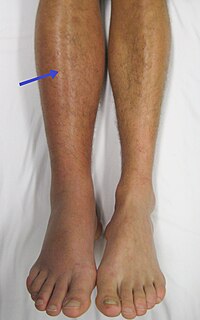
Photo from wikipedia
Objectives The use of postoperative anticoagulation is not uncommon for patients undergoing lower extremity arterial procedures as adjunctive therapy. Longer postoperative length of stay is necessary to achieve adequate therapeutic… Click to show full abstract
Objectives The use of postoperative anticoagulation is not uncommon for patients undergoing lower extremity arterial procedures as adjunctive therapy. Longer postoperative length of stay is necessary to achieve adequate therapeutic international normalized ratio with traditional protocols that call for the use of unfractionated heparin and warfarin therapy. We hypothesized the direct oral anticoagulants are an attractive alternative to provide adequate anticoagulation in patients who undergo lower extremity arterial procedures. Methods We retrospectively studied patients who had lower extremity arterial procedures between 2012 and 2015 to examine the safety and efficacy of the direct oral anticoagulants in a single institution. Patency, freedom from re-intervention, and major adverse limb event were evaluated. The direct oral anticoagulant agents used included dabigatran, rivaroxaban, and apixaban. The primary patency, adverse effects and freedom from re-intervention were then compared to a control group of patients who were treated with traditional heparin–warfarin therapy after lower extremity bypass procedures. Results Direct oral anticoagulants were utilized in a total of 23 patients (48% men; mean age 69 ± 11 years) during the study period. Indication for use of direct oral anticoagulant after procedure included use of polytetrafluoroethylene (PTFE) bypass graft below the knee joint or after lower extremity angioplasty with disadvantaged runoff. Mean follow-up of the drugs was 23 months (SD ± 16 months). At the end of follow-up, the direct oral anticoagulants have been discontinued in four patients, who are currently only on plavix. Among 82.6% of patients who were given direct oral anticoagulants for PTFE bypasses, graft patency, freedom from re-intervention, and major adverse limb event were 100%, 100%, and 0%, respectively. Patients (17.4%) treated with direct oral anticoagulants for disadvantaged runoff after balloon angioplasty of the lower extremity, patency, freedom from re-intervention, and major adverse limb event were 100%, 100%, and 0%, respectively. For the patients who underwent direct oral anticoagulant administration for disadvantaged runoff primary patency was 100%. One patient developed wound dehiscence which was unrelated to direct oral anticoagulant administration. Our control group consisted of 100 patients who were treated with heparin–warfarin therapy for 30 days after lower extremity bypass procedures. The graft patency, freedom from intervention, and major adverse limb event were 93%, 12%, and 0%, respectively. There was however no statistically significant difference in graft patency rate (P = .34) or freedom from intervention (P = .07) between the two groups. Conclusions The preliminary data suggest that there may be a role for using the direct oral anticoagulants with patients who undergo lower extremity arterial procedures for prevention of thrombosis and warrants further investigation.
Journal Title: Vascular
Year Published: 2018
Link to full text (if available)
Share on Social Media: Sign Up to like & get
recommendations!